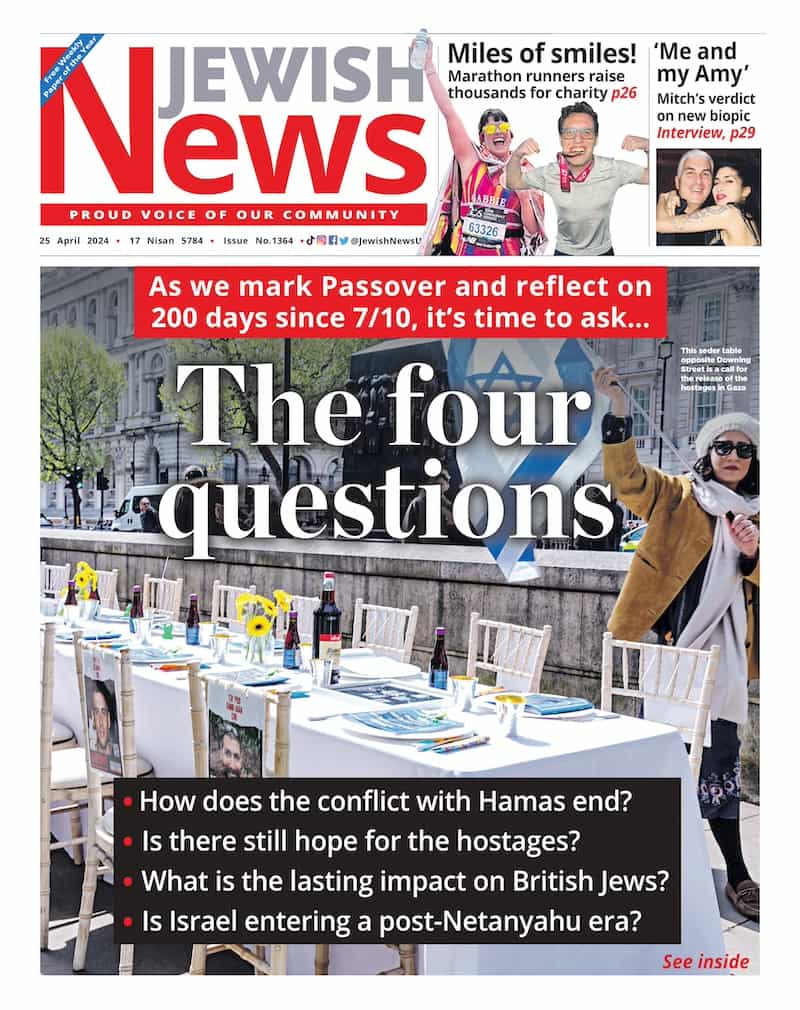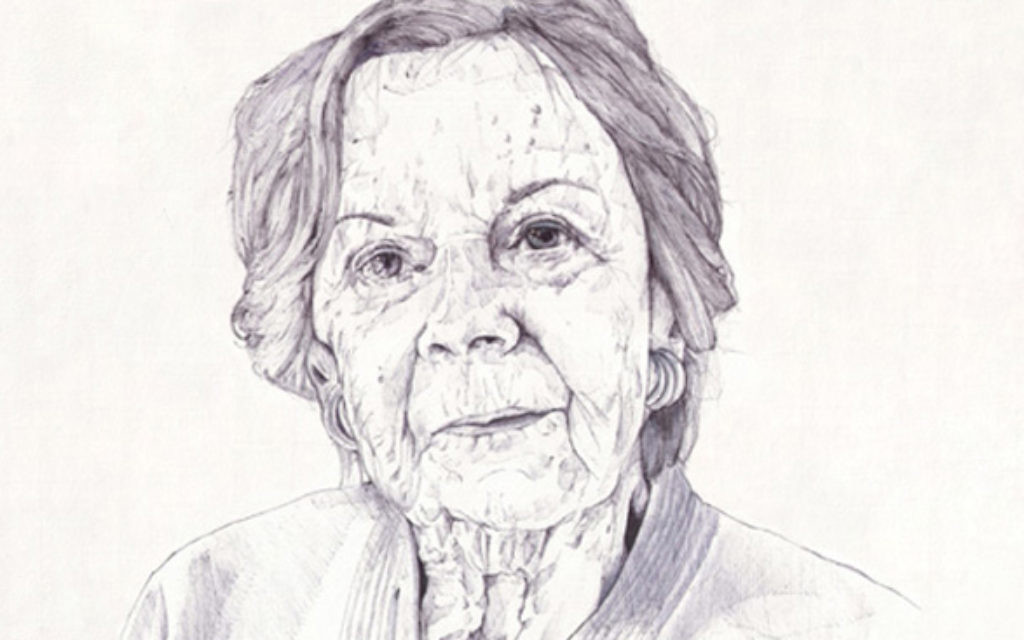Drawing strength: a young artist sketches 10 Holocaust survivors
Artist Gideon Summerfield drew 10 special people – and says they changed his life

Budding artist Gideon Summerfield embarked upon a life-changing challenge last summer by deciding to draw a series of portraits of 10 Holocaust survivors.
The former JFS pupil was introduced to staff at Jewish Care’s Holocaust Survivors Centre in Hendon and spent every Tuesday during his summer holiday meeting the survivors, listening to their experiences and drawing and painting with them.
Get The Jewish News Daily Edition by email and never miss our top stories Free Sign Up
Now, a year on, 19-year-old Gideon returned this week to present the survivors with the originals of their portraits as a pictorial legacy for them to pass down to their families.
Here, Gideon talks about this meaningful project in his own words:
“Faced with 10 weeks of summer holiday, I had a plan. Sleep, eat, party, see friends, sleep a bit more.
Then my dad interfered with my plan: “How about you sleep, eat, party… and do something else?” he said. He wanted me to use my drawing skills and to meet survivors of the Holocaust.
The rationale was that the survivors were in their twilight years, in their late 80s and early 90s, so now was a good time, possibly the only time, to get to meet them and hear their life stories.
I found myself attending an art class held at Jewish Care’s Holocaust Survivors Centre in Hendon. Art classes and art therapy are a regular part of the busy schedule at the centre.
Weeks passed and I found myself visiting the homes of the survivors. I looked at their faces and began to draw. As I drew, some of them talked about what happened to them when they were children, separated from their parents.
When they found themselves in concentration camps. When their parents were murdered. Within days, I found myself overwhelmed with the enormity of the experience.
Meeting extraordinary people who had led extraordinary lives. I am not embarrassed to admit I often found myself crying when they were crying. Some did not want to talk so much and if they did they could not talk about their time during the war. They preferred to talk about family, their children and grandchildren.
Ten portraits were completed. In most of them, the survivors are holding something precious to them. Usually it’s a photograph of parents or a family member who perished in the Holocaust. The summer ended and I began a degree course in Illustration at Cardiff School of Art and Design.
A few weeks into term, I received an unexpected phone call. One of the survivors, Harry, had died. I travelled back to London for the funeral and met Harry’s friends, the other survivors. They have become my friends too.
It has been an enormous privilege to meet and draw Harry, Alicia, Freddie, Renie, Sigi, Moshe, Zdenka, Eva, Zahava and Avram. When I started this project, I thought it would be about meeting and then drawing 10 survivors. What I didn’t expect was the development of 10 meaningful relationships or that the portraits would become a testament to these relationships.
Earlier this week, I was back at the survivors centre, presenting the original portraits to their subjects. It was wonderful to see them all again. I know how important legacy is to so many survivors and I hope this, their own pictorial legacy, is something they may choose to pass down from generation to generation”.
• See: www.gideonsummerfield.com

AVRAM AND VERA SCHAUFELD
Avram was born in Chorzow, Poland in 1926. He spent time in several concentration camps, including Bergen-Belsen, Buchenwald and Auschwitz. He came to the UK in 1954. In his portrait he is pictured with his wife, Vera. The couple have been married for 62 years after meeting on a kibbutz after the war.
EVA SCHLOSS

Eva was born in Vienna in 1929. She emigrated to Belgium and then to Holland in 1938, shortly after Hitler annexed Austria. After the Germans invaded the Netherlands in 1942, her family went into hiding but in May 1944 were betrayed and sent to Auschwitz-Birkenau, where her brother and father perished. After liberation, her mother married Otto Frank, the widowed father of Anne Frank. Eva is holding a photo of her brother Heinz, who perished at Auschwitz just days before the liberation. He was 17.
HARRY ROSSNEY

Harry was born in Konigsburg, East Prussia in 1919. He came to England in 1939 and served in the British Army, where he met artist Lucien Freud. Harry passed away on 25 October, 2013. Harry is pictured holding a photograph of his mother and brother.
ZAHAVA KOHN
Zahava was born in Palestine in 1935 and moved with her family to Amsterdam two years later. In 1943, the SS transferred

Zahava and her family to Westerbork transit camp. A year later, she was sent to Bergen-Belsen. Her father and mother survived and were transferred out of the camp in February 1945 as part of an exchange for German prisoners of war. Zahava and her parents moved to Switzerland and then to England in 1961. Zahava is holding a photo of her mother, father, two sisters and two children.

RENIE INOW
Renie was born in Elberfeld in Germany on 5 August 1929. She came to England on the Kinderstransport in May 1939. She is pictured holding a photograph of her parents, who perished during the Holocaust.
SIGI CIFFER
Sigi was born in 1925 in Marcalgergely, Veszprem in Hungary. He was a slave labourer in the Mauthausen concentration camp

in Austria and arrived in the UK in 1946. Sigi is shown holding a postcard which was written by his mother to his uncle and which survived the war. He treasures the fact that the postcard carries his mother’s handwriting.

ZDENKA FANTLOVA
Zdenka was born in Czechoslovakia in 1923. She was sent first to Theresienstadt and in 1942 her boyfriend Arno gave her a handmade tin ring for their engagement. Arno was sent east and never seen again. In 1944, Zdenka was transported to Auschwitz-Birkenau with her mother and sister. Zdenka saved her sister from selection when they arrived, but their mother was sent to the gas chambers. Before the end of the war, she endured camps at Kurzbach, Gross Rosen, Mauthausen and finally Bergen-Belsen. Sadly, Zdenka’s sister died from typhoid.
ALICIA GORNOWSKI

Alicia was born in Warsaw in 1925. When the Nazis arrived, Alicia was separated from her family and she lived for some time in the Warsaw Ghetto. She escaped and spent the rest of the war hiding in an orphanage. In 1946, she came to Britain with the help of Rabbi Solomon Schonfeld, who helped to rescue 110 orphaned children. Alicia’s parents, Celina and Malricy, and all her family perished in the Holocaust. The photo Alicia is holding is one of just two photographs she has of her late mother.

MOSHE GALILI
Moshe was born in Erdobenye near Budapest in 1930. He and his sisters survived the war in hiding. In 1948, he arrived in Palestine just before the State of Israel was established and after military service he studied art in Jerusalem, Italy, France and London. He has lived in the UK since 1962. He says he has always enjoyed a passion for painting and sculpture and in the portrait can be seen with his sketch book.
FREDDIE KNOLLER
Freddie was born in Vienna in 1921. After joining the French Resistance, he was betrayed, arrested, tortured and eventually

sent to Auschwitz. Towards the end of the war, he was forced on to a death march to Dora Nordhausen camp in Germany. He was liberated by the British Army in Bergen-Belsen. He moved with his wife Freda to the UK in 1952. Freddie is pictured showing the number tattooed on his arm, which serves as a reminder for him to ensure these atrocities are never forgotten.

Thank you for helping to make Jewish News the leading source of news and opinion for the UK Jewish community. Today we're asking for your invaluable help to continue putting our community first in everything we do.
For as little as £5 a month you can help sustain the vital work we do in celebrating and standing up for Jewish life in Britain.
Jewish News holds our community together and keeps us connected. Like a synagogue, it’s where people turn to feel part of something bigger. It also proudly shows the rest of Britain the vibrancy and rich culture of modern Jewish life.
You can make a quick and easy one-off or monthly contribution of £5, £10, £20 or any other sum you’re comfortable with.
100% of your donation will help us continue celebrating our community, in all its dynamic diversity...
Engaging
Being a community platform means so much more than producing a newspaper and website. One of our proudest roles is media partnering with our invaluable charities to amplify the outstanding work they do to help us all.
Celebrating
There’s no shortage of oys in the world but Jewish News takes every opportunity to celebrate the joys too, through projects like Night of Heroes, 40 Under 40 and other compelling countdowns that make the community kvell with pride.
Pioneering
In the first collaboration between media outlets from different faiths, Jewish News worked with British Muslim TV and Church Times to produce a list of young activists leading the way on interfaith understanding.
Campaigning
Royal Mail issued a stamp honouring Holocaust hero Sir Nicholas Winton after a Jewish News campaign attracted more than 100,000 backers. Jewish Newsalso produces special editions of the paper highlighting pressing issues including mental health and Holocaust remembrance.
Easy access
In an age when news is readily accessible, Jewish News provides high-quality content free online and offline, removing any financial barriers to connecting people.
Voice of our community to wider society
The Jewish News team regularly appears on TV, radio and on the pages of the national press to comment on stories about the Jewish community. Easy access to the paper on the streets of London also means Jewish News provides an invaluable window into the community for the country at large.
We hope you agree all this is worth preserving.
-
By Brigit Grant
-
By Laurent Vaughan - Senior Associate (Bishop & Sewell Solicitors)
-
By Laurent Vaughan - Senior Associate (Bishop & Sewell Solicitors)
-
By Laurent Vaughan - Senior Associate (Bishop & Sewell Solicitors)
-
By Laurent Vaughan - Senior Associate (Bishop & Sewell Solicitors)






















